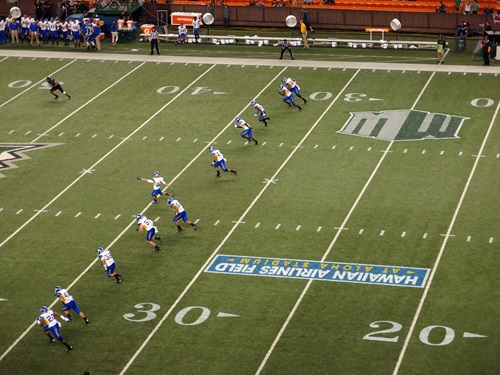
Colleges (and venues where colleges play) that are looking for new sponsorship income will be glad to hear that the NCAA has approved the presence of commercial logos on the field for regular-season games in all three divisions, starting with the 2024 season.
Under the new rule, corporate advertisements can be placed in three spots on the field: A single advertisement centered on the 50-yard line is allowed, in addition to no more than two smaller flanking advertisements elsewhere on the field. This could be done on a game-by-game basis or for the whole season.
And, of course, the NCAA has reasons: “One rationale for the rule change is to align regular-season games in home stadiums with those already existing advertisement allowances for games played in the postseason bowl games and neutral-site games. This move also provides an additional revenue opportunity for schools that have not been available during the regular season.”
Of course, even without NCAA’s blessing, some schools have been putting logos on the field, and reaping the benefits of it, for years.
"I grew up in Syracuse, New York, so I was accustomed to the Carrier Dome, which is now the JMA Wireless Dome," SEC commissioner Greg Sankey told ESPN reporters at the conference's spring meetings in Destin, Florida. "So, this is not new within the college sports enterprise. We've had clear lines, so it hasn't been appearing on the field. I would anticipate there's going to be a continuing push of those limits."
 And by no means are school required to add logos to their field – nor to anywhere else.
And by no means are school required to add logos to their field – nor to anywhere else.
"We're pretty traditional," Alabama athletic director Greg Byrne told ESNP reporters. "One of the cool things I think is that Alabama doesn't change their jerseys. We're unique in that way. Never say never but we obviously are fairly conservative when it comes to what we do from anything like that."
The change comes at a welcome time, noted the Associated Press, since “many Division I schools expect their athletic budgets to be stressed by the House v. NCAA settlement. The antitrust settlement, announced last month, would require back damages of $2.77 billion to be paid over 10 years to more than 14,000 former and current athletes who say now-defunct rules prevented them from earning money from endorsement and sponsorship deals dating to 2016. Also, beginning in 2025, each school would be permitted, but not required, to set aside up to $21 million in revenue to share with athletes each year.”
But the logo issue could make up for at least a portion of that shortfall, says NBC Sports, and allow schools to bypass begging alumni and others for money:
The presence of logos will be glaring, at first, for fans. Most should be used to seeing it; corporate logos have been an integral part of the bowl season for a long time. And no one ever turned off a bowl game because they were miffed by the infiltration of toaster-pastry product placement. The new rule also puts programs in competition, sort of, with players. Companies have finite advertising budgets. The schools will be trying to get that money for their fields. The players will be hoping to get some of the money for themselves. And the end result will be just a little more chaos for a system that deserves every ounce of chaos it is experiencing.”
The current rule applies only to NCAA football; however, other sports are also played on fields, including field hockey, lacrosse and soccer. In addition, there are plenty of other high-visibility sports surfaces, where logos could grab eyeballs (not to mention sponsorship dollars); these include ice, hardwood, pool floors or decks, etc. SDM asked NCAA whether other sports are under consideration for rule changes with regard to logo placement on playing surfaces. NCAA responded that the proposal had been put forth only by the NCAA Football Rules Committee.

